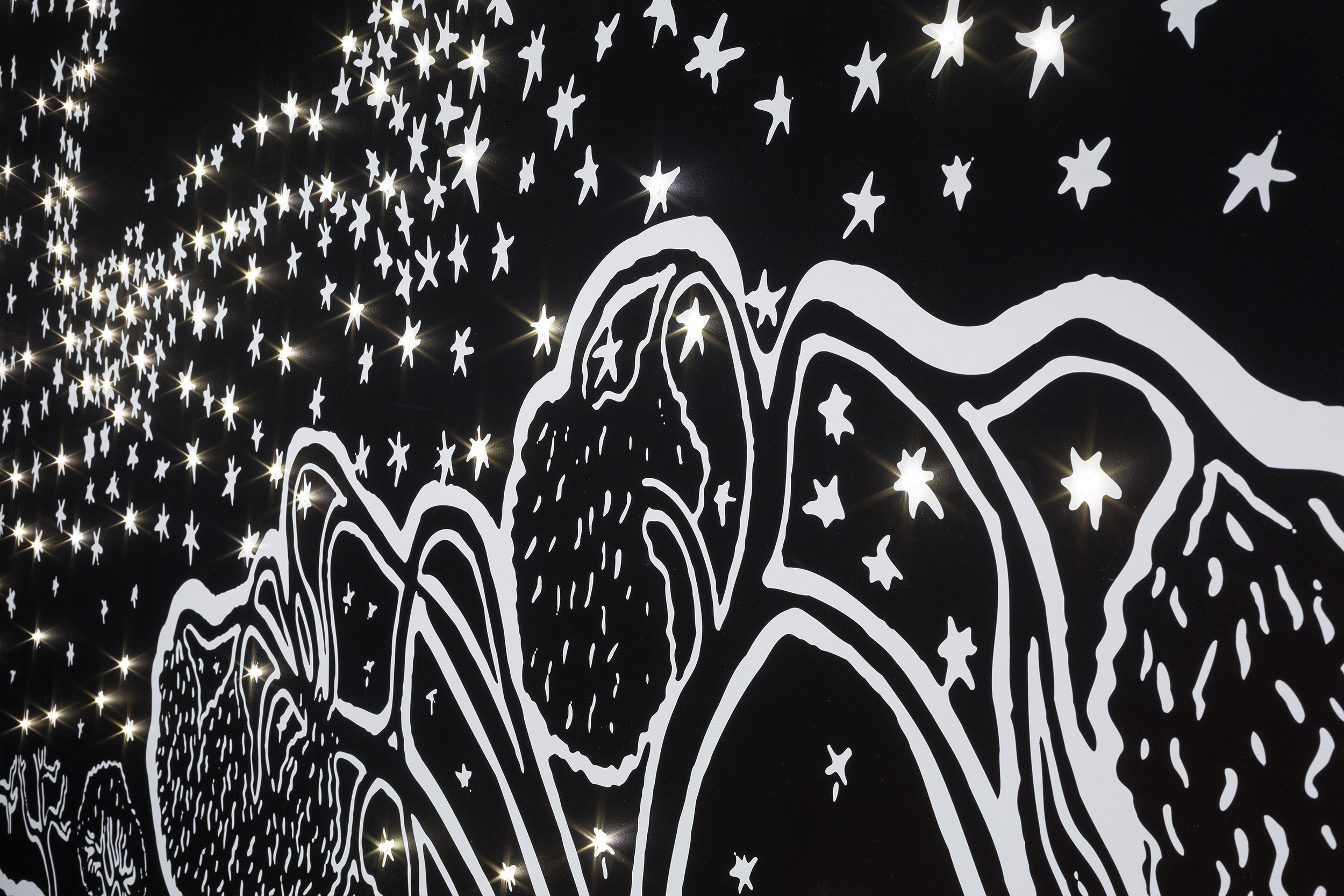


vinyl print, lighting
reproduced from the original
Emu Sky 2008
linocut print on paper
43.1 x 70.9 cm
Courtesy the artist
Emu Sky is one of a large body of linocut works made over many years by Uncle Badger Bates to illuminate and share the cultural stories of his Barkandji Country.
The ‘emu in the sky’, which acts as a map for living across many diverse Indigenous groups across Australia, is not known through looking at ‘the stars’ but is instead formed by a dark space, and can be understood only from the holistic Indigenous perspective of ‘looking at the sky’, not just the stars. Much of our complex knowledge as Indigenous peoples may be seen to sit within these ‘dark spaces’ that the western lens has been unable to recognise. The architecture of perception – what people have been overwhelmingly taught, has not allowed for the illumination that comes with the acceptance of and respect for other ways of seeing.
Barkandji
born Wilcannia, New South Wales 1947
lives and works Broken Hill, New South Wales
Uncle Badger Bates (William Brian Bates) was born on the Darling River at Wilcannia in 1947. He was brought up by his extended family and his grandmother Granny Moysey who spoke several Aboriginal languages and knew many traditional songs and stories. With his grandmother he travelled the country learning about Barkandji language, history and culture. He was employed by New South Wales National Parks and Wildlife Service (NPWS) as an Aboriginal Sites Officer for 21 years, and this enabled him to continue travelling the country looking after important places and teaching young people about their culture and their country. He retired from the NPWS in 2004 and is now a full-time artist and cultural heritage consultant.
Uncle Badger Bates produces artworks in a variety of media, including: linocut prints; wood, emu egg and stone carving; mosaics; and metalwork. His art often reflects the motifs, landforms, animals, plants and stories of Barkandji country and the interconnected ecosystems of the Barka (Darling River).
When I look at the Emu Sky it relates me to our people in other parts of Australia because they all look at the same thing - and sort of, we all know that, so that really locks us Aboriginal people into our culture, is that emu in the sky. And in some places it’s called different but we call it Kalthi.
To us Aboriginal people, and of course we can look at the emu sky and put our mind back to forty or fifty thousand - what our old people done a long time ago, and with the stories we tell.
When it's summertime the emu, the milky way, it changes. That's where the emu is. In there is the dark spot in there, and in the summer the stars change and the head go up. So we wait until it’s getting towards winter and then the head will drop down like it is now. The stars change again and it drops the head down and that's telling you that that's the time the emu is laying.
And the only time the emu won’t lay is when it’s a drought. If it's in good season the emus will lay all the time. And why the emu is putting its head down is because it's hiding itself, because you can't see it’s protecting the eggs.
And sometimes in the country where the emus lay their eggs if it’s in black country like on the Darling-Barka, the river where I am - in our country. The emu on the black country’s got a lot of roly poly and they look like a bush. But even in the red country the emu will go to something what it’ll try match it’s colour to lay its eggs and that how it’s put its head down.
And sometimes if you’re not quick and looking and taking notice out there - so when we go hunting we mustn't talk all the time, we must look and observe the landscape because the emu is nearly the colour of the landscape. Remember that the emus feather is nearly the country, the colour of the country where its living, and it sort of change that little bit of colour - and birds will do this.
And that's what the old people learned us - we must observe the country. And so when we go hunting we’re not going round all over the place and looking for things - we can go to the place and know where it is.
Close